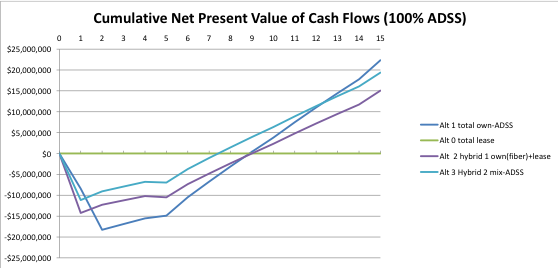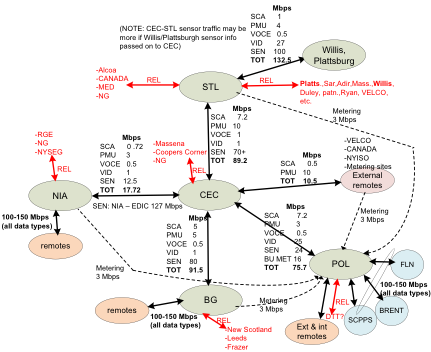Quanta Technology supports utilities with the development of telecommunications strategies and plans as part of our grid modernization programs. Our capabilities include establishing and developing requirements for the grid-edge as well as wide area networks.
Telecommunications Strategy & Design for Grid Modernization
Telecommunications networks in electric utilities are moving away from being used for a single purpose towards being a unified single platform for all different types of data. This presents utilities with entirely new challenges, as each data type has its own performance requirements. With grid modernization requirements that overlay the telecommunications infrastructure, the challenges become even greater. Utilities must choose a modernization path appropriate for its environment.
Telecommunications Strategy & Design
Quanta Technology uses a modular approach to integrated communications strategy (ICS) and roadmap development that is tailored to each utility’s specific needs. The analysis identifies network strengths, weaknesses, opportunities, and threats (SWOT), so strategies are developed to fill in gaps and to prioritize the most cost-effective technologies. We have several complementary service offerings to support all aspects of telecommunications strategy and design.
Industry Benchmarking
Technologies must be tested, and their performance validated, before full-scale deployment. This includes the establishment of private networks, as well as considerations for outsourcing telecommunications to public carriers. Quanta Technology leverages its vast network of contacts to develop a thorough understanding of industry standards and trends to ensure new solutions are adequately benchmarked:
- Fiber deployment (distribution and transmission)
- New technology introduction
- Commercial telecommunications practices and trends
Communications Assurance: Cybersecurity & Cyber-Physical Security
Communications assurance ensures that the communications network is a safe, reliable entity that can be trusted to deliver data, regardless of environmental or “cyber” conditions. Often, our plans are used as justification to regulators. Two aspects of this consulting include:
- Assessing Cybersecurity in the Mission-Critical Environment: Methodology that yields an in-depth defense and layered security architecture. This involves identifying holes in existing architecture, security control framework, security products, and capability deployments. From there, we identify solutions that can be integrated throughout.
- Providing Storm Hardening / Vulnerability Analysis: We use existing communications system-hardening and resiliency requirements and identify vulnerabilities and risks to weather events such as hurricanes, wind, and ice storms, as well as other emergency situations. From there, we recommend ways to mitigate vulnerabilities and risk.


Why Quanta Technology?
Quanta Technology’s team includes experts in system protection, communications, IT, maintenance, control centers, and NERC reliability standards, as well as business case analysis. They are uniquely qualified to provide services to bridge gaps among these multiple functions in the utility organization and can provide support from project inception, all the way through final implementation and acceptance.
Proven Methodology
Quanta Technology’s experts will help your utility develop an integrated communications strategy (ICS) and roadmap. The ICS is developed through a series of assessments conducted in phases. When formed together, they lay out a comprehensive roadmap that best fits your objectives, both operationally and businesswise.
Key steps of our methodology include:
- Working with stakeholders to identify evolving business requirements such as DER, EV, AMI, transmission, substation, distribution automation, enterprise IT, and operational WAN/FAN/Edge.
- Assessment of current infrastructure to understand its ability to support present and future requirements.
- Development of technology, cost, and resource requirements related to rehabilitation/enhancement needs.
- Incorporation of business objectives and sourcing strategies (i.e., lease vs. own).
Representative Case Studies
New York Power Authority (NYPA): Smart generation and transmission (G&T) communications backbone study
Dominion: Grid Modernization Roadmap
Florida Power & Light: Fiber Benchmarking Study
Commonwealth Edison (ComEd): Distribution Fiber Benefits Study
MISO: DER Communication, Telemetry, and Metering Study
San Diego Gas & Electric: Reference architecture development; testing of protective relaying over MPLS network
Grid Modernization
A grid modernization strategy and approach is important to meet business objectives through benefit-cost analysis and cost-effective communications implementation, while also ensuring the network meets performance criteria for mission-critical operations. Some key considerations of a grid modernization strategy include:
- Distributed Energy Resource (DER) and Renewable Energy Resources (RER) Integration: Quanta Technology engineers solve DER and RER integration problems and work on leading-edge projects for DER and RER integration. We work with TelCos to coordinate connecting facilities, as well as evaluating site-connectivity options. Whether the components are solar, wind, and/or microgrids, telecommunications interconnection is critical for successful deployment. Using telecommunications systems, remote operators can poll real-time data, send commands, and reconfigure the network for power and energy.
- Wide-Area Network (WAN) Enterprise IT/OT Telecommunications & Integration: Quanta Technology develops, implements, and helps justify WAN telecommunications strategies and enterprise integration plans tailored to each client’s specific needs and objectives. Enhancements to a utility’s telecommunications infrastructure support the flow of electric power and information between power companies and their consumers. Requirements include the capability to integrate back-office applications with emerging field networks, including field message bus or third-party “cloud” services.
- Field Level & Grid Edge Telecommunications: “Smart” distribution offers a strategic, holistic way to approach grid efficiency and reliability upgrades, providing a solid foundation for smart distribution, smart metering, and smart consumer capabilities. Feeder-level platforms, such as OpenFMB, serve as telecommunication and aggregation hubs that communicate to individual DER assets – via low-cost DER gateways – and other field devices, including those with embedded phasor measurement units (PMUs). Cloud services may fill in some gaps, but security is a key consideration. Quanta Technology experts have tested and understand the most relevant use cases for grid modernization field applications. For additional information on Field Area Communications and Monitoring, please see our capabilities sheet.
System Automation, Protection, and Control
Quanta Technology experts guide major utilities as they modify and update their designs and organizational support for transmission and distribution system/substation protection, control, and communications. Our multidisciplinary team works with clients to assess the state of existing systems and collaborates on new designs and approaches. The aim is to solve problems and bring benefits to each utility.
Some of the key communications-related consulting includes:
Communications Systems and Equipment for Transmission Line Protection and Transfer Trip Schemes:
- Pilot protection schemes and the scheme interaction with the characteristics of the pilot communications channel
- IEC 61850 peer-to-peer GOOSE messaging; inter- and intra-substation
- Time division multiplexing (TDM) over Ethernet for protective relaying applications
- Communications for wide-area protection schemes (system integrity protection schemes [SIPS])
- Multiplexed digital communications systems – T1/E1 and/or SONET/SDH with microwave or fiber-optic media
- Direct fiber-optic communications
- Relay to channel equipment digital communications
- Power line carrier communications equipment
- Practices and design for carrier coupling systems, including switchyard equipment
Data Communications for System/Substation and Enterprise Integration Including Ethernet Networking: support of testing, test plan development, and testing oversight, including proof-of-concept testing/vendor evaluation, type testing, and commissioning of key mission critical applications.
Substation Integration: mapping data and information requirements to unify substation integration architectures, including add-on systems and support of legacy systems. Data communications needs to support operational needs – SCADA and EMS. Modern integration architectures tie together communications, RTUs, host processors or data concentrators, and substation servers to serve the needs of multiple clients at multiple remote sites.
Communications Protocols for Substation Integration including IEC 61850: Our industry experts have been part of the development of the IEC 61850 protocol since its inception in 1995 – and through its absorption of EPRI UCA in 2000 – to yield the single international multi-vendor standard for substation protection and data integration. We help utilities map specific services of IEC 61850 to design practical substation protection and control systems, with assessment of products, tools, risks, and risk mitigation strategies for each facet of the solution.

